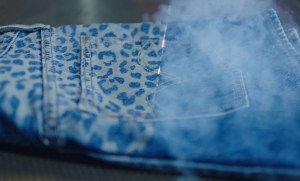The 150th anniversary of the 501 is not the only milestone Levi’s is celebrating this year.
Last weekend, Levi Strauss & Co.’s (LS&Co.) marked 10 years since the Eureka Innovation Lab opened in San Francisco. The R&D lab has played a central role in Levi’s adoption of new technologies, water-saving strategies, digital sampling and design.
In 2013, then-new CEO Chip Bergh moved the lab from Turkey to just a few blocks from its global headquarters. The move unpinned Bergh’s vision for Levi’s to become an innovation-led company.
In a blog post, Bart Sights, LS&Co. VP of technical innovation, described the lab as a “guiding light in our efforts to evolve with the times, driven by an ethos that revolves around reevaluating old practices with fresh eyes, preserving what enhances our capabilities and reimagining what does not.”
“This has led Eureka to produce a variety of innovations in different spaces that have contributed to the business and aim to minimize waste, maximize quality and reduce time to market, all while retaining the heritage brand identity that sets us apart,” he wrote.
Eureka birthed Project F.L.X., the 2018 operating model that ushered in Levi’s era of digital finishing and became the catalyst for other innovations.
By digitizing design files and automating parts of the jeans finishing process that had previously required more time and manual labor, Levi’s has been able scale a more responsive and sustainable supply chain, reduce lead times from more than six months down to weeks or days, and slash the number of chemical formulations used in its finishing processes from thousands to just a few dozen.

Levi’s
Using lasers from Jeanologia to create worn and faded design elements reduced finishing time from two to three pairs per hour to 90 seconds per garment, followed by a final wash cycle, Levi’s stated. Additional imaging tools allow Levi’s designers to finesse finishes and final garments faster. The digital files are sent directly to the vendor and scaled for manufacturing.
Project F.L.X. led to the creation of Future Finish, a program that uses proprietary laser technology to let consumers customize their jeans with one-of-a-kind finishing details. The customization opportunity has become a “showstopper” at popup experiences, Sights said.
F.L.X. has also served as the catalyst for the Eureka team to continue combining their technical skills and expertise with new digital capabilities, Sights added. The team members who were once focused on the more mechanical aspects of manufacturing, shifted gears to develop software, including new processes that allowed for photo-realistic digital 3D renderings of denim and apparel samples. These technologies proved to be beneficial during the pandemic when in-person meetings were impossible.
Eureka’s impact on products and sustainability continues.
In 2011, the Eureka team developed water-saving finishing techniques, which went on to set the standard for denim finishing, Sights said. In 2014, they launched the Screened Chemistry program, taking a hazard-based approach with chemicals to identify and substitute best-in-class or better alternatives from the onset. Both processes, he added, were open-sourced and shared across the retail industry, promoting more sustainable finishing practices and chemistry on a broader scale.
The lab is also where Levi’s reduced the number of master patterns required from 65 to 30 for its then-new women’s collection in 2015. It also launched Lots 700 and 300, which included popular styles and fits like the 710, 711, 720, 721, 311 and 312.
“Our most radical undertakings are the result of a team that’s willing to think unconventionally and take risks,” Sights said. “When you can back up big ideas with technological capabilities—that’s where change happens.”
